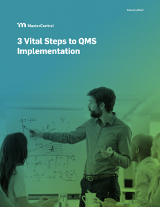
GxP Lifeline
Improving User Adoption With a Quality Management System

Every branch of industry has tried to overcome the user adoption hurdle during quality management system (QMS) implementation. Most users want to learn the new quality management software, but some will struggle to learn the necessary items because of lack of experience, time constraints, and upgrade concerns.
So…what can we do to improve user adoption, since engaging with new QMS software is essential for driving business success during the implementation of a quality management system?
End users will adopt quality management software when they learn how to use the product and discover its value, so let’s focus on five major tips to encourage user adoption:
1. Build an Adoption Strategy
Focus on strategy points that include:
- Setting goals for training completion levels and success metrics.
- Implementing software education and user training.
- Inviting users to experience the quality management software’s added value.
- Measure success by tracking user engagement and participation.
2. Streamline Training
During QMS implementation, utilizing a scaled, access-based training approach for your user groups will ensure users are only training on the process and system functions they will need. Additional trainings can build on the lower-level prerequisites. For example: While a user with view-only rights would only take the first training session listed below, a new document control admin would take all of the following trainings in numerical order, with each session building on the previous one to improve knowledge retention:
- i. View-Only/Basic User Training
- ii. Document Creator/Collaboration Training
- iii. Document Approver Training
- iv. Document Control Admin Training
3. Create Process-Based Training Materials
Creating training materials that focus only on the system functions and specific processes that each user group will employ, encourages quality management software learning and engagement. With the streamlined training approach mentioned above, presenting each training session with coordinating process-specific training materials will give your users better direction within the QMS. After training is complete, these materials will still be helpful for your users as references that they can utilize to walk them through step by step.
4. Reinforce the Trainings
To support the quality management software trainings, provide easy user guides that can be referenced by users to quickly review process configurations and system functions they have learned. In my experience, having these guides available to the users during troubleshooting calls significantly helped to reinforce the trainings because I could walk users through the process while they actively referenced the training material at the same time.
These guides work best when designed like an icon roadmap that is a single/double-sided page that can be printed.
5. Dedicate Space and Time for End User Questions
During go-live launches and major updates of your quality management software, host regular open house-style meetings (either virtually or in a conference room) to dedicate time for end user questions, and encourage your users to engage in these spaces if they have any thoughts. This will help alleviate lingering user issues and increase user confidence because they have a dedicated space to share concerns and will be more likely to ask the “silly questions.”
In my experience, many QMS users are hesitant to ask questions, but creating a dedicated space for them to approach you, combined with an easy user guide to walk them through the process in the future, will have the biggest positive impact on your company’s user adoption during QMS implementation. Combined with a training plan that breaks all-day trainings down into smaller, process-specific sessions, these strategies will fast-track user learning and reinforce their knowledge for the long-term.

